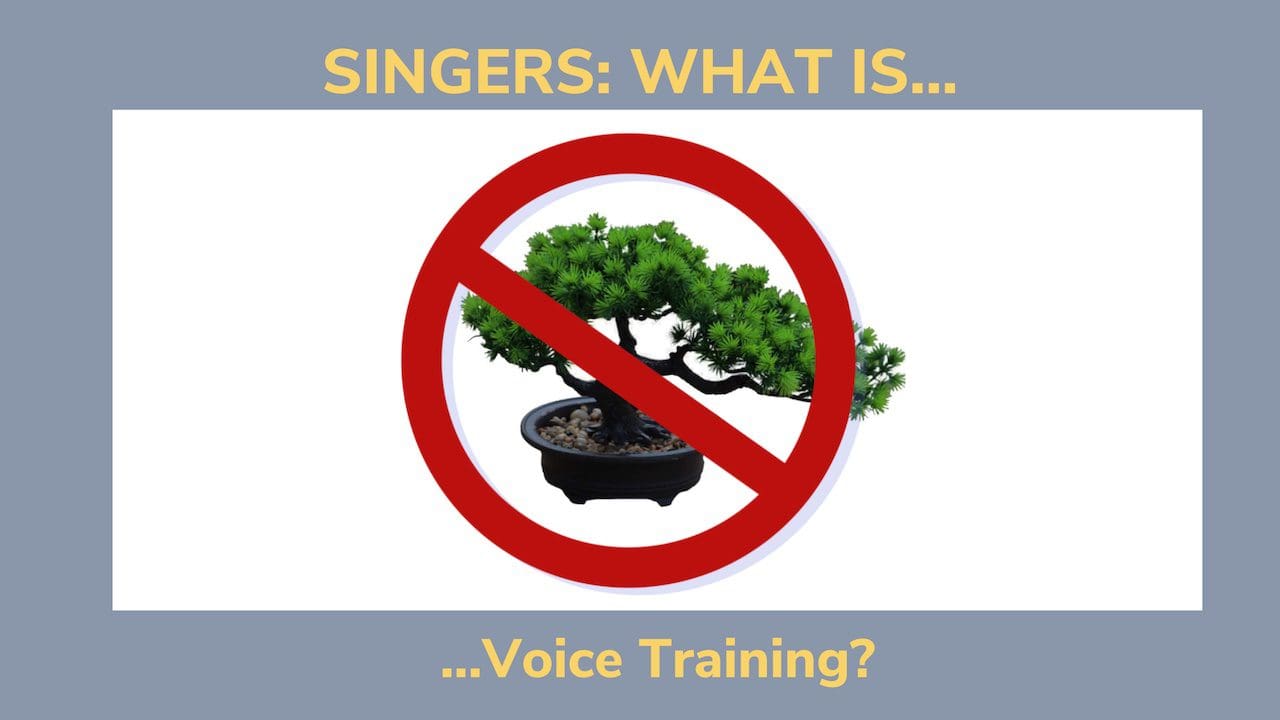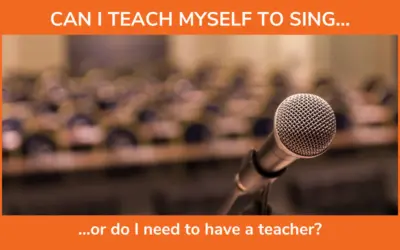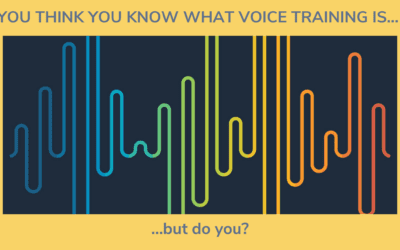Most people, when they hear the term “voice training” think it’s a good thing. They think… I’m going to train my voice to do healthy things, better things, professional things – and by the use of exercises, determination and repetition, make my voice what it should be, what I want it to be.
And, of course that’s what we all want in the end – we want our voice to do what we want it to do on demand and we want it to happen at the healthiest and highest and most respectable levels possible.
But, because that’s what we want – the “good stuff” – we think that the best way to get that is to cut out the “bad stuff.” So we try to make that happen and call it “training.” But that’s focusing on the result as if it were the process itself. By and large, this is what “voice training” has become. But, sadly, this type of training is not going to get you where you want to go (and if it does, it won’t last very long), because trying to force the result through control, repetition, limitation and pruning the “bad parts” away is just not how we learn, it’s not how our system works, not for real.
trying to force the result through control, repetition, limitation and pruning the “bad parts” away is just not how we learn, it’s not how our system works, not for real
Robert Sussuma
The etymology of the word training itself gives us a clue or two as to where this idea of “training” came from and why it won’t work:
Train (v.)
“to discipline, teach, bring to a desired state by means of instruction,” 1540s, probably from earlier sense of “draw out and manipulate in order to bring to a desired form” (late 14c.), specifically of the growth of branches, vines, etc. from mid-15c.; from train (n.). Sense of “point or aim” (a firearm, etc.) is from 1841. Sense of “fit oneself for a performance by a regimen or exercise” is from 1832. The meaning “to travel by railway” is recorded from 1856. (etymonline.com)
So, with this image for training, vocal training has become just that… a pruning process, a process of sculpting and reinforcing only the “good” and desirable options (according to the dominant class, of course). All the rest is wrong, bad or even threatening. In extreme cases, this is why we are told to “do only this, and NEVER do that.” And, if you’re a classical singer, of course don’t EVER “belt.” That will ruin your classical voice. This is also why we are given exercises and told what the correct outcome should be before we even try it. (BTW what makes an exercise an exercise and not a learning experience is that it has a goal that is stated beforehand and one attempts to reach that goal by means of said exercise.)
Under this model, we limit vocal possibilities, eliminate what is not desired, and only allow and reinforce what is wanted. The rest is discarded, hidden, ignored or stored away. Or to put an even finer point on it… it’s colonized. This is colonialism in action, people.
This approach might work with plants, but it won’t work with people and voices and here’s why:
The voice is not a thing and our use of it is not reducible and prune-able like a tree.
What the voice IS is a series of learned possibilities that are infinite, ever-changeable and updatable.
No matter how they are organized, all possibilities exist as part of a huge fractal of potential movements, coordinations, patterns, functions and options.
Also, there is no one way to do anything! In voice, we have sound equivalents – different ways to create a similar acoustic output. So, there’s that too!
And let’s not forget that in order to be a vocal artist with any sense of mastery we need many colors and sounds at our disposal… sounds that are precise and technical, contextualized and aesthetic, emotionally expressive and personal. The more we have available the more we will be able to choose from in order to express what we are performing in a truthful manner. And, the truth is unpredictable! So our singing must give the illusion of unpredictability through organized, intentional freedom in order for it to express some of that truth in performance!
And this is true whether you are singing in one style or many. And, now it is pretty standard that most singers should be able to sing in various styles and authentically!
So, how could “training” in the traditional sense (aka pruning) work with so many variables and a need to have them all available, but not “in the way” of any others at any given moment?
It cannot.
So what should we do instead?
Imagine a full range of options and coordinations. 1 to infinity. Some you know, some you don’t. Some you will need to find through learning. Some you may find immediately useful, some you may not know what to do with at all, but here they are. And instead of cutting them out, you realize that EVERY option is potentially useful in some situation somewhere, somehow so it would be good for it to be there, available if you ever need it, but until then it needs to live somewhere in the WORLD OF YOUR VOICE in an organized way.
So how do we do this…? Through learning. Through experimenting. Through play. But, not mindlessly, no. With awareness, attention, sensitivity to sensation and ease and pleasure while TRUSTING the system – our amazing body/brain/mind/self – to organize it all under the general heading of “Singing.” So that when we “sing,” we can consciously/unconsciously navigate through all of these options using our moment-to-moment intention and everything we have ever learned is there for us when we need it.
That’s why THE SINGING SELF PROGRAM is not a training program in the usual sense. For one, there are so many different classes and experiences – seemingly unrelated, but all related – in a linear/non-linear way. It is all ONE BIG LESSON. And, it is designed that way so that you can learn to open up and organize all of the different aspects of your voice not so that you can reduce it into some strange bonsai tree, but so that you expand and expand, coming at the same things again and again but from different angles and learn to hold them all together by your moment-to-moment intention to sing. That’s it. There’s even a great class in there called VOCAL VERSATILITY EXPANDED in which I guide you to learn a song without learning it any one way so that the way you “learn” a song does not ever preclude any option for being expressed through it.
In fact, there’s no such thing as a “song.” There’s no such thing as “your voice.” These are all constructs and ideas that we reify, that we believe to be solid. They are not solid. Your voice is ALL your voice, all of the possibilities it contains all at once – even the parts you don’t know yet – and it is what you choose to do at any given moment.
I call this your BIG VOICE!
It’s huge. It’s wild. It’s EVERYTHING!
If you REALLY want to “train” your voice… stop training it the old way – stop thinking of it as an “it” at all – and start exploring, learning, organizing and optimizing all of the possible pathways into a spontaneous, organic and easily navigable sense of your own complex, beautiful and functional SINGING SELF.
You don’t train your voice by un-wilding it! You train it by letting it be all that it is and organizing it to be a flexible and responsive system that you can shape and re-shape any way you want!





0 Comments